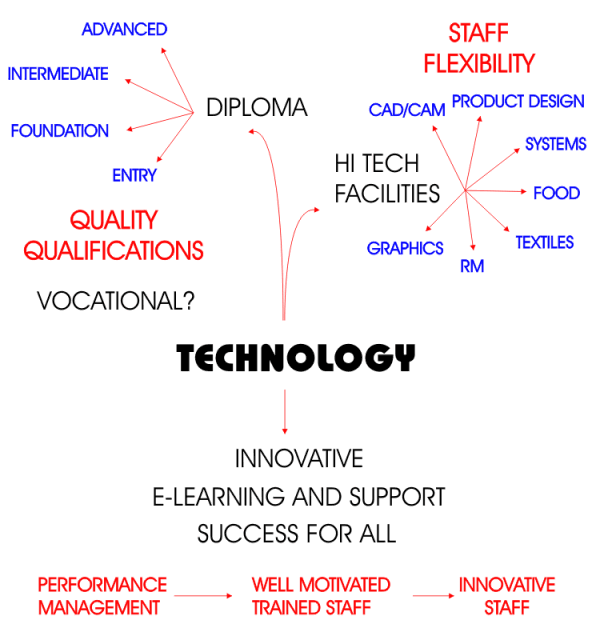 |
|
| THE TECHNOLOGY DEPARTMENT OF THE FUTURE | |
|
The Tomlinson Report (interim report) emphasises the need for flexibility. Pupils will attempt components from a range of subject areas, building up credits towards a Diploma. In Design and Technology this may mean that pupils choose a number of components from all aspects of the Design and Technology Department. The DT Department of the future must educate and prepare pupils so that they have a broad knowledge of technology and transferable skills. Staff need to be flexible and multi-skilled so that they can deliver a wide range of Design and Technology subject areas. Gone have the days when a member of the Design and Technology Department can specialise in one area (e.g. Engineering). Staff must be able to deliver a diverse range of short components rather than long two year courses. They must be capable of changing from the delivery of one aspect of technology to another, depending on the choices made by pupils. The Government has a great responsibility to ensure that funds are available to train staff, allow time for planning and preparation and to equipment Design and Technology Departments with modern hi-tech resources. Without a good level of funding the reforms outlined in the Tomlinson Interim Report will inevitably fail. |
|
|
The W.A.T.T. Research Team suggest that Design and Technology Departments prepare for the inevitable reforms by: 1. Increase the range of technology subjects offered by the Department. These may include existing courses such as Food, Resistant Materials, Systems and Control, Graphic Products. 2. Introduce vocational courses. Consider Double Award Engineering or Manufacturing. The Tomlinson Report emphasises the role of vocational courses. Consequently, Design and Technology Departments need to move quickly in this direction. 3. Establish / strengthen links with industry and business. This will help the Department write and develop meaningful vocational courses and modernise existing courses. People from business and industry have a wealth of experience and the Design and Technology Department of the future will need to 'tap' this resource. 4. Strengthen links with the Science, Maths AND Art and Design Departments. These Departments will inevitably support the delivery of key aspects of the new Diploma. The Design and Technology Department of the future cannot be successful in isolation. 5. Strengthen links with Further Education. The Department of the future should develop meaningful links with Sixth Form Colleges and Universities. The W.A.T.T. Research Team suggest that Design and Technology Departments develop and share the delivery of vocational courses (and other courses). Further Education Colleges often have well equipped workshops and other facilities that ordinary schools cannot match. Sharing facilities and staff expertise could be beneficial to the those schools and colleges that work together. 6. Technology staff must be flexible in what they can deliver. Specialisation in areas such as Engineering and Graphics is probably at an end. Staff who cannot adapt may limit the range of subjects the Design and Technology Department can deliver and limit their own futures. Investment in training is a key issue. 7. The Design and Technology Department of the future should extend access to knowledge through the extensive use of E-Learning. The development of detailed websites and intranet sites will help pupils access the knowledge and resources they need to be successful in their credits / components / courses. Pupils should be able to access these resources twenty four hours a day. One detailed resource already exists - www.technologystudent.com . This has been developed to help teachers and pupils/students studying or delivering aspects of Design and Technology. One E-Learning development is the production of a project template backed up with resources available on the internet. (see project template on www.technologystudent.com ). 8. Performance Management must be central to staff professional development. A good Head of Department must ensure that his/her staff are fully supported in their careers. (see the Performance Management section of this website). The Design and Technology Department of the future must put emphasis on good Performance Management. Through this, members of the Department will be motivated and with good guidance display innovation. 9. The Design and Technology Department of the future must invest in CAD/CAM. Several companies manufacture CAM machines and one of the most prominent is BOXFORDs, based in Halifax, Yorkshire, England. The type of machines placed in the DT department should by capable of 3D manufacture, probably converting design files from software such as pro/Desktop. The WATT Research team are clear in that 3D modelling is an essential ingredient of departments that intend to lead the delivery of Design and Technology. CAD/CAM interests pupils of all abilities and in particular pupils who intend to work towards careers in Design and Technology and all its aspects. CAD/CAM is an important aspect of manufacturing industry and as such schools must invest heavily in this technology. |
|
|
|
|
|
|
|
|
|

